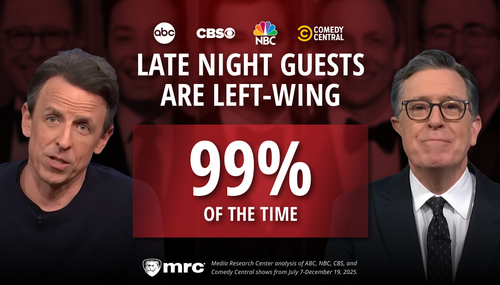No
rising price affects the American psyche like skyrocketing gas prices.
After all, many people drive past one or more gas stations each and
every day, making it impossible not to see the prices soar. Then when
the weekly, or bi-weekly fill up time rolls around, they feel the pain
acutely.
How
network news media cover the consumer issue seems to have a lot to do
with who resides at 1600 Pennsylvania Avenue. NBC News is a perfect
example – covering rapidly rising prices in 2008 three times more than
far higher prices in 2013.
In
February 2008, NBC news programs “Nightly News” and “Today” spent a
whopping 22 minutes 36 seconds talking about gas prices, from
interviewing people struggling between food or fuel, to warning
consumers about potential rip offs at the pump. Gas prices climbed from
$2.988 to $3.164 that month. Prices were a problem that “could get a lot
worse,” according to NBC.
February
2013 gas prices were at record highs for the time of year.. They
started out much higher ($3.462 on Feb. 1, to $3.771 by March 1) than
February 2008 and rose further, but NBC devoted far less coverage to the
issue: only 6 minutes and 43 seconds. That means there was more than
three times as much coverage in the 2008 study window on that network.
As of March 5, 2013, gas prices had retreated slightly to a national average of $3.73 a gallon.
ABC and CBS devoted similar amounts of time to the issue in both 2008 and 2013, but the stories were still much more negative in 2008. Both of those networks brought up the idea that the U.S. was undergoing “stagflation.”
According to Merriam-Webster, stagflation is “persistent
inflation combined with stagnant consumer demand and relatively high
unemployment.” But according to the Bureau of Labor Statistics, the
unemployment rate for February was 4.9 percent (announced in March
2008).
Gary
Wolfram, William E. Simon professor in economics and public policy at
Hillsdale College, told Business and Media Institute that the media were
“mislabeling the problem.” Although there is no technical definition of
stagflation, it is normally a period of high unemployment and high
inflation.
“Unemployment
nationally was rising in 2008, from 4.6 percent in 2007 to 5.8 percent
in 2008 and it rose quickly from there to 9.3 percent in 2009 and 9.6
percent in 2010. On the other hand, the CPI [Consumer Price Index] rose
only at 3.8 percent average for the year 2008 over 2007, and the average
over 2009 was .4 percent less in 2009 than in 2008. So overall prices
were not rising very fast, compared to the Carter era where the term was
coined,” he explained adding that annual inflation was 7.6 percent in
1978, 11.3 percent in 19769 and 13.5 percent in 1980.
Networks Show Pain in 2008, Focus on Supply Disruptions in 2013
The pain of high gas prices was evident among network stories in February 2008, but much less so in 2013,
even after the Energy Information Administration announced that
households spent nearly four percent of pre-tax income on gasoline in
2012. That tied with 2008 for “the highest percentage in roughly 30 years,” according to Ben Geman of The Hill.
NBC
“Nightly News” aired a heartbreaking testimony on Feb. 27, 2008. The
network interviewed Virginia Mereno who said, “I only had so much money,
so I just did not buy groceries. I had to put that money in the gas
tank.”
CBS “Evening News” had a similar story to tell. On Feb. 29, 2008, correspondent Bill Whitaker spoke with Leslie Martinez who “tries to work at home two days a week. Not for convenience, for cost.” But the Martinez family wasn’t the only one suffering, according to Whitaker the “whole country is feeling her pain.”
NBC “Today” co-host Matt Lauer also complained about the “sky high” gas prices and warned they were causing pain in other places, not just the pump – but also at the grocery store.
Back
then the networks anticipated that prices would continue rising. “Gas
prices already now high and headed higher,” was Bill Plante’s
pessimistic assessment on Feb. 28, 2008. That was in a story about the
country possibly heading into recession. In 2008, prices did eventually
rise to $4.11 in July and the country did succumb to recession. But for
years the networks had made similar predictions only to be proved wrong.
In
February 2008, ABC warned that $4-a-gallon gas would be “common by
spring.” Even when prices fell a bit, NBC undermined the news saying
“Even so, gas prices are up about 74 cents a gallon from a year ago.”
Although
drivers expressed frustration over high gas prices, sob stories were
much harder to find on the networks in 2013. On “Nightly News” Feb. 18,
Brian Williams mentioned that gas “prices [were] now really hurting
everybody who drives.” But instead of focusing on that pain, Tom
Costello’s report attempted to answer the question of why prices were
going up.
About
two weeks earlier, Costello’s “Today” report also looked at the reasons
for the gas price hike. He mentioned refinery shutdowns, the rising
price of oil and more. After interviewed a few complaining drivers,
Costello optimistically reported: “while gas prices may move higher in
the coming weeks, over the coming months they could go lower.”
On
Feb. 25, ABC’s Josh Elliot reported on “Good Morning America” the “good
news” that “prices are finally beginning to level off” because oil is
starting to drop. Unlike in 2008, the reporter did not undermine the
news.
Even
when ABC marked the 35th day in a row that gas prices “ticked up,”
“World News” only gave 24 seconds of airtime to the issue, saying
tensions in the middle East were one of the reasons for the surge.
Compared
to its very downbeat coverage in 2008, CBS did a good job covering gas
prices in February 2013. One thing that helped its recent coverage was
the network’s decision to consult oil analyst Tom Kloza for a couple of
stories. One of those was a lengthy on set interview Feb. 23, 2013, with
the respected oil analyst with the Oil Price Information Service.
A History of Gas Price Hype
Spinning
economic stories is one way the media criticize or protect presidents.
On the issue of gas prices, there has been a huge difference between
treatment of the issue under George W. Bush and Barack Obama.
Bush,
a Texan, was a pro-oil president, and for years was battered by the
network media on the subject of gasoline prices. In May 2004, network
morning and evening shows aired story after story about “skyrocketing” gas prices.
Gas prices at the time were above $2 a gallon, but well below inflation
adjusted records set in 1981. At the same time, a dropping unemployment
rate and the creation of 288,000 new jobs got little attention.
In
2006, the media took gas price conspiracy theories seriously, attacking
Bush with claims that he was involved with “plummeting gas prices.”
Also in 2006, the networks bemoaned rising fuel costs, while again downplaying about the great economic conditions including very low unemployment and a climbing stock market.
2008 was a year of pumped up predictions, as Business and Media Institute noted in a Special Report that year. Network
reports continually said there was no relief in sight and prices would
only get worse. They predicted $5 or $6-a-gallon. Those predictions were
wildly incorrect, and gas prices actually peaked at $4.11 nationally.
In
February 2008, CBS also portrayed Bush as out of touch, showing press
conference video of the president unaware of predictions about
$4-a-gallon gas.
In contrast, President Barack Obama practically promised rising energy prices. In a January 2008 interview
he promised bankruptcy to anyone foolish enough to build coal power
plants, under his cap-and-trade plan. But the media virtually ignored
it.
Although
Obama did not succeed with cap-and-trade, he has cracked down on energy
production through the Environmental Protection Agency. He also
instituted a moratorium on oil drilling permits following the Deepwater
Horizon disaster.
Under
his administration, the national average for gasoline has more than
doubled since his inauguration in 2009 and the nation has experienced
sustained high gas prices, but that has gotten little criticism from the
network news media. BMI found that when comparing a month of coverage
in 2008 to 2012, the networks had hyped the rising gas prices 4 times more for Bush than Obama.
During
Bush’s tenure, gas prices were a huge economic threat and cause of
suffering. The networks also used the high gas prices to attack the
administration. In 2012, the networks aired mostly matter-of-fact
stories on the rising gas prices, and worried primarily that they would
hinder the economic recovery, not that they are making people suffer.
Methodology
The
Business and Media Institute compared how much time was spent talking
about gas prices from Feb. 1, 2008, through Feb. 29, 2008, to Feb. 1,
2013, through March 1, 2013 (since 2008 was a leap year, and 2013
wasn’t). Entire stories were only counted if gas prices were woven
throughout the economic discussion, otherwise only the mention of gas
prices was counted toward the overall times for each network. Stories
that mentioned only oil prices were excluded, as well as stories about
waiting in gas lines due to weather and references to “big oil” or Exxon
profits if they were not connected by the reporter to gas prices. Jet
fuel stories were also excluded.





